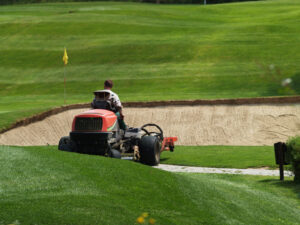Golf Course Herbicide, Pesticide, and Pollution Liability
 To the golfer, there’s nothing quite as relaxing as the beautiful green of a golf course at tee time. The manicured grass ripples gently in the wind as you survey the course before you. The water hazards, sand bunkers, and wooded areas create an aesthetic though challenging terrain. It’s a thing of beauty. However, the golf course owner sees things a bit differently. While the lawns, ponds, and woods are certainly aesthetic, they also represent an expense. Maintaining golf courses takes significant time, effort, and a little bit of love. But did you know: the materials used to protect course lawns come with inherent risks worthy of liability coverage?
To the golfer, there’s nothing quite as relaxing as the beautiful green of a golf course at tee time. The manicured grass ripples gently in the wind as you survey the course before you. The water hazards, sand bunkers, and wooded areas create an aesthetic though challenging terrain. It’s a thing of beauty. However, the golf course owner sees things a bit differently. While the lawns, ponds, and woods are certainly aesthetic, they also represent an expense. Maintaining golf courses takes significant time, effort, and a little bit of love. But did you know: the materials used to protect course lawns come with inherent risks worthy of liability coverage?
Herbicide, Pesticide, and Pollution Liability: Who Can Be Harmed?
While herbicides and pesticides are powerful products which can eliminate unwanted weeds and bugs, they are made of potent chemicals which must be used properly. There are three main groups which can be harmed by the dangers associated with herbicide, pesticide, and pollution liability.
- Employees who work on the grounds or other employees who are onsite everyday could be endangered by chemicals in the substances applied to the course. The medical risks of overexposure by mishandling these chemicals are not pretty.
- Customers run the same risk, albeit to a lesser degree, since they likely will not be there on a daily basis.
- Third parties such as neighbors or those the course’s eco-system (for example, properties downstream from course waterways) can be harmed by the spread of dangerous chemicals which can have lasting effects.
Why You Need Herbicide and Pesticide Liability
Herbicide and pesticide insurance is often associated with farms for obvious reasons. However, golf courses need their own coverage, as they often apply pesticide, herbicide, and fertilizer to keep the grounds weed and pest free. With the proper insurance policy, courses will have coverage as long as their equipment, chemicals, and regulations are not in violation of local code. Unbeknownst to many course owners, this can be an easily exposed weakness in standard liability insurance coverage. Many general business policies (BOPs) have exclusions where the policy doesn’t cover bodily injury or property damage due to toxic chemical release.
Why You Need Pollution Liability
Pollution liability is a mandatory form of insurance for golf courses. Without adequate pollution liability, owners may end up paying heavy compensations. Many courses store substances in tanks underground (occasionally above). For example, the chemicals which are used on the lawns, or simply the fuel and oil needed to operate golf carts and equipment are often stored in tanks. If these were to leak or be damaged in a storm or fire, the environmental fallout could be quite damaging to the area around the course. This can lead to huge expenses.
While herbicide, pesticide, and pollution liability are often not the most commonly discussed among golf course owners, they need to be taken seriously. It’s key to not only have the proper coverages, but have sufficient amounts. If you have any questions about your herbicide, pesticide, and pollution insurance or other country club coverages you should carry, please contact the H&K Insurance Agency. We would love to discuss the potential risks to your club and how they can be reduced.
Brian began working at H&K Insurance Agency in 1992. He is a Certified Insurance Counselor (CIC), and an exceptionally qualified insurance professional helping clients protect their assets, and create future financial security in all areas of insurance. Brian is a sponsor of The New England Club Managers Association and specializes in helping golf clubs manage risk by creating insurance plans to protect clubs and their members. Brian oversees H&K’s regular donations to charitable organizations at both local and national levels, and runs seminars for local communities on how to protect their assets with insurance contracts.
